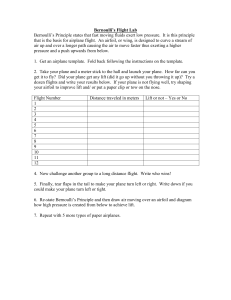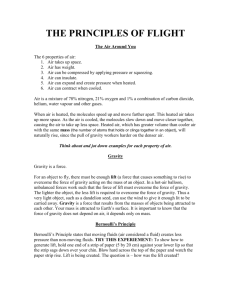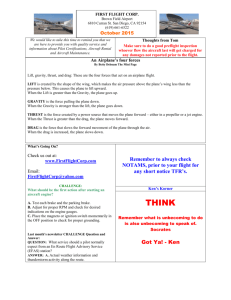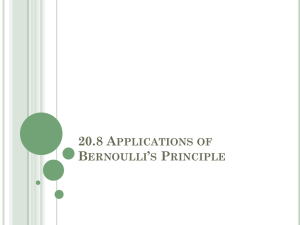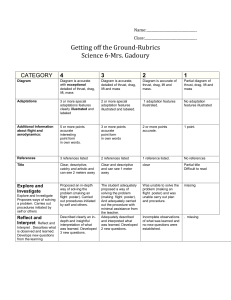Flight principles explained PowerPoint
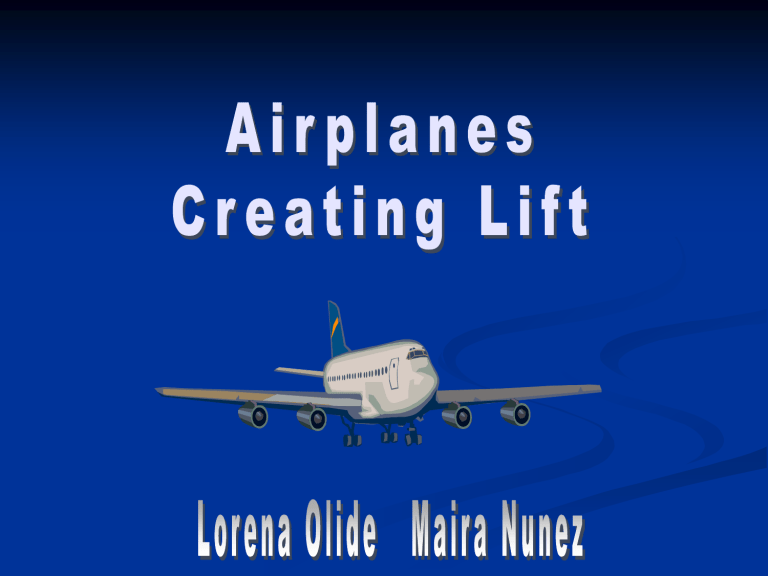
Overview
Brief discussion of the 4 forces acting on a plane
Brief definition of the 4 forces
Weight
Drag
Thrust
Lift
How lift is developed
Two Perspectives on how lift is created
Demonstrations
Factors that affect lift
Forces
Force – a push or a pull acting on a body.
As a plane flies it is in the center of
4 forces.
Weight, lift, drag and thrust
Two natural forces being exerted on plane
Weight and drag
A pilot needs to overcome weight and drag to achieve flight
Two forces a pilot needs to create to overcome weight and drag
Lift and thrust
Lift & thrust are required to keep the airplane in the air
Drag
Lift
Weight
Thrust
Weight
Weight is defined as the downward force of gravity
Force is always directed toward the center of the earth
Weight is distributed throughout the plane
The magnitude of the weight depends on the mass of the plane plus the fuel, the people and baggage
A pilot must overcome weight by lift to get the plane in the air
Drag
Drag is a resistance force created by the plane’s movement through the air
The force of the air pushes against the plane, therefore slowing the plane down
The magnitude of drag depends on the shape, air quality and velocity
Drag increases as air speed increases
A pilot must overcome drag with thrust to gain speed
Thrust
Thrust is defined as the forward push that gets the plane into the air
Thrust is artificially created and used to overcome drag and to sustain lift
This force is provided by the propeller or jet engine
Thrust is also used to accelerate and gain altitude
Lift
Lift is the upward force on a plane
Various parts of a plane help to achieve lift
But most of the lift is created by the wings
The magnitude of lift depends on the shape, size and velocity
For example, the faster the plane goes the greater the lift
The lift that is produced by the wings must be greater than the weight of plane to leave the ground
Two Perspectives
Two explanations to help understand how lift is created
Both contribute to creating lift
Bernoulli’s Principle
Largely depends on the shape of the wing
Concentrates on speeds and pressures in the airstream
Involves pressure imbalances
Newtonian Explanation
Largely depends on the tilt of the wing
Concentrates on the acceleration of the passing airstream
Involves the deflection of the air stream
Important Concepts - Air
Principal concept in aerodynamics is the idea that air is a fluid
Air has mass, therefore it has weight
Because it has weight, it exerts pressure
Air flows and behaves in a similar manner to other liquids
Air has molecules which are constantly moving
Lift can exist only in the presence of a moving fluid
Faster moving fluids exert less force on surfaces they are flowing along
Before We Begin…
As an airplane moves forward, the airflow splits up into two separate flows copyright 2006 Kevin Bailey
Bernoulli’s Principle Defined
Bernoulli’s Principle states that when the speed of a moving fluid increases, the pressure decreases and when the speed of a moving fluid decreases, the pressure increases.
Daniel Bernoulli
18 th century Swiss Scientist
©2003 m. mitchell
Bernoulli’s Principle
Air flowing around the wing experiences a change in speed and each change in speed is accompanied by a change in pressure
Airflow going under the wing encounters a sloping surface
Slows airflow down and slow moving air maintains a higher pressure on the bottom surface
Airflow going over the wing encounters the up/down sloping
Slows the airflow down, then it speeds it up; with the faster moving air a lower pressure develops on the top surface
Air going over must travel farther, so its average speed is greater than the speed of the air below
Result: A reduction in sidewise pressure which occurs at the top, exerting a lifting force on the entire wing
Pressure imbalance produces an overall upward force
Conservation of Energy
(Bernoulli’s Principle)
Bernoulli principle derived from the Law of Conservation of Energy
A fluid under pressure has potential energy.
Energy can be stored in pressurized air
The higher the pressure the greater the potential energy
Moving fluids have both potential energy and kinetic energy.
Total energy must remain constant, so its potential energy decreases, and which means its pressure decreases as well
When the air’s speed and motional energy increase, the pressure and pressure energy must decrease to compensate
Speed increases over the wing because the airflow converts some of its pressure energy into kinetic energy
BERNOULLI’S PRINCIPLE
DIAGRAM
Fast Moving Air; Low Air Pressure
Air travels farther
Leading edge airfoil
Trailing edge
Slow Moving Air; High Air Pressure
Shape of the Wing
The distance traveled is the same. Equal distances in equal times means the air is traveling at same speed. There’s no net force=no lift.
The curved shape is a longer distance so the air is traveling faster. Equal distances traveled in equal times. No net force=no lift.
The air on top is traveling faster. It exerts less force.
When 2 forces are combined they do not cancel each other out. Therefore there is some net force upward.
Bernoulli’s Principle
Newtonian View
Newton’s Third Law states that “for every action there is always an equal but opposite reaction.”
Newton’s Third Law, is often called the Law of
Conservation of Momentum, which states:
When an object is given a certain momentum in a given direction, some other body will receive an equal momentum in the opposite direction
This theory predicts that as the air stream passes by, it is deflected downward.
Both top and bottom surfaces of wing play important roles in deflection
© Texte Olivier Esslinger 2003-2006
Newtonian View Explained
As the airflow separates, they both experience two different accelerations
Flow under
encounters downward slope; airflow is deflected downward (action), and the air stream reacts by pushing the wings up (reaction).
Air molecules impart some of their momentum to the wing, therefore nudging wing
Flow over travels up, over and down
Initially flow encounters upward sloping surface-pushes it upward
This upward force causes air to push downward on the leading portion of wings top surface
Top surface is curved, so it soon begins to slope downward
Before airflow leaves trailing edge there is a slight downward component to its motion
This airflow must accelerate downward to stay in contact with surface
In both cases, wing has made the air accelerate downward by pushing the air downward.
Downwash – downward velocity behind the wing (downward deflection of airflow)
Upwash – slight upward flow of air at leading edge
NEWTONIAN’S VIEW DIAGRAM
Air is not just flowing from left to right but upward/downward
Airfoil
Downwash
Upwash
Wing gets a momentum downward from air. According to
Law of Conservation of Momentum, the wing gets an upward momentum in the opposite direction equal to the downward momentum
Experiment 1
Demonstrates Bernoulli’s Principle
1.
2.
Hold paper horizontally just below your lips (let paper hang limp).
Blow hard over the top of the paper.
What happens to the paper?
Paper responds by moving up toward the air stream.
Why does this happen?
Moving air above is at a lower pressure, so paper is lifted up by higher pressure below it.
copyright Terry Colon, 2006
Experiment 2
Cup full of water
Straw
Scissors
Results: Blowing over the straw will make the air move faster over the top of the straw. The air pressure above the straw will decrease and the water will go up the straw and squirt out.
Explanation : The difference in the air pressure over the straw and the rest of cup is what lifts the water
Factors Which Affect the Amount of
Lift Created
Speed
The faster the wing moves through the air the more air is forced over and under
So a plane must maintain ample velocity to keep the upward lifting force
If it slows down too much—lift decreases—plane descend
Density of air
The denser the air the more lift (colder air is more dense; air density changes with altitude)
Planes climb better in winter.
Shape of wing
Asymmetrical
Angle of attack (its tilt relative to the wind)
Downside: increases drag
Sources
Texts
Physics Made Simple by Ira M. Freeman, 1990
Inquiry Into Physics by Vern J. Ostediek & Donald J. Bord, 1987
Websites
www.howstuffworks.com/airplane.htm
http://Howthingswork.virginia.edu/airplanes.html
www.grc.nasa.gov/WWW/k-12/airplane/forces.html
www.allstar.fiu.edu/aero/airfly/vl3.htm
www.washington.edu/faculty/eberhardt/lift.htm
www.av8n.com/how/htm/airfoils.html
http://sln.fi.edu/flights/own2/forces:html www.alphatrainer.com/handouts/ac61-23c.pdf
